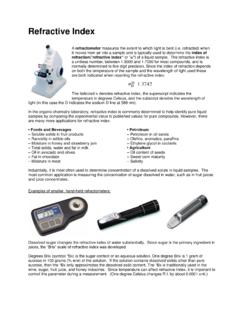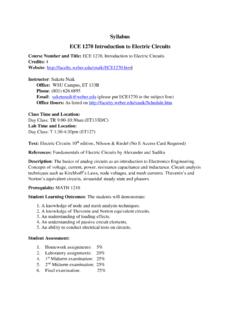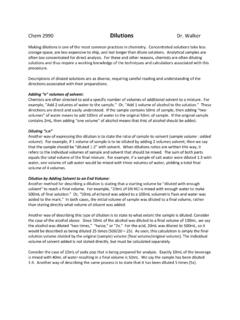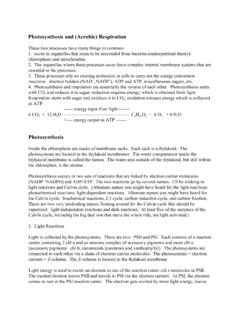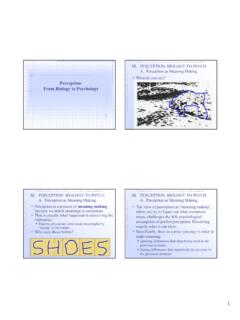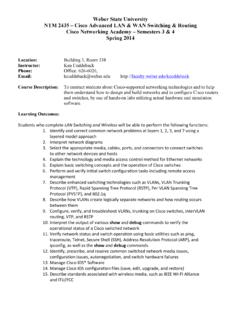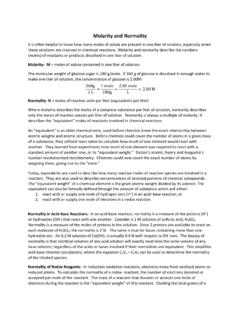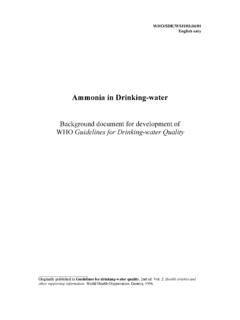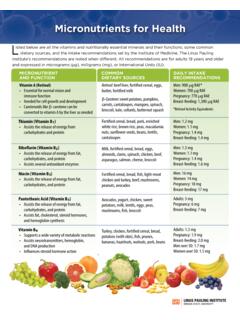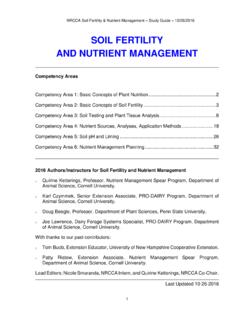Transcription of Carbon and Nitrogen Cycles
1 Carbon and Nitrogen Cycles What process? ? What does it need? Microbiology: An Evolving Science 2009 W. W. Norton & Company, Inc. 2. Biogeochemical Cycles n All living organism elements flow in Cycles Rate of cycling varies n Biomass vs. organic n Environment: atmospheric, land, or ocean n Lack of necessary elements limits growth iron Phosphorus Fixed Nitrogen Micronutrients Microbiology: An Evolving Science 2009 W. W. Norton & Company, Inc. 3. Biogeochemical Cycles n Elements move from large sources to sinks Reservoirs provide both n Ocean important for Carbon , Nitrogen n Land important for sulfur n Oxidation state governs element reactivity Nitrogen gas plentiful, fixed Nitrogen rare n Measure elements in atmosphere via Chemical reactions Radioactivity measurements Microbiology: An Evolving Science 2009 W. W. Norton & Company, Inc.
2 4. Carbon Cycle n Major reservoir is ocean Atmosphericreservoir is much smaller n Aerobic Carbon cycling Photosynthesis fixes CO2 into biomass n Produces organic Carbon compounds Lithotrophs also reduce CO2 to biomass Respiration returns CO2 to atmosphere n Net gain of O2, loss of CO2 in photic zone Microbiology: An Evolving Science 2009 W. W. Norton & Company, Inc. 5. What process? ? What does it need? Microbiology: An Evolving Science 2009 W. W. Norton & Company, Inc. 6. RUBISCO & Calvin Cycle n CO2 + ribulose 1,5-bisphosphate (5C) 2 (3C). phosphoglyceric acid n 6 2 (from RUBISCO rxn) + 12 + 18 . C6H12O6(PO3H2) + 12 NADP+ + 18 ADP + 17 Pi n Where does all the NADPH and ATP come from? Microbiology: An Evolving Science 2009 W. W. Norton & Company, Inc. 7. Photosynthesis n Photo: Light energy used to make ATP. and reducing power (NADPH).
3 N Synthesis: Use ATP and NADPH to reduce CO2 to Sugar RUBISCO. Calvin Cycle Microbiology: An Evolving Science 2009 W. W. Norton & Company, Inc. 8. Photosynthesis n Oxigenic: n Anoxigenic: (not the same as anaerobic). Microbiology: An Evolving Science 2009 W. W. Norton & Company, Inc. 9. Carbon Cycle n Anaerobic Carbon cycling Lower cycling rate than aerobic Cycles n Less iron , and less redox potential than oxygen Subsurface environment n Soil, benthos, rock Fermentation, lithotrophic respiration n Incomplete breakdown of biomass Carbon n Formation of peat, oil, gas Microbiology: An Evolving Science 2009 W. W. Norton & Company, Inc. 10. Carbon Cycle n Human activity accelerates CO2 release Ocean absorbs most CO2. Increased photosynthesis absorbs CO2. n Forests, ocean environments n Atmospheric CO2. levels rising Roleof newly discovered microbes unclear Microbiology: An Evolving Science 2009 W.
4 W. Norton & Company, Inc. 11. Wastewater Treatment n Natural treatment Wetlands filter water n Slow water passage n Bacteria in wetland denitrify water n Municipal treatment Reduce nutrients to reduce BOD. n Allow microbes to grow, digest nutrients n Aerate to restore oxygen levels Microbiology: An Evolving Science 2009 W. W. Norton & Company, Inc. 12. What process? ? What does it need? Microbiology: An Evolving Science 2009 W. W. Norton & Company, Inc. 13. Nitrogen Cycle n Multiple oxidation states of Nitrogen More than for any other biological molecule n Prokaryotes crucial for Nitrogen conversion Only natural Nitrogen fixers n Haber process doubled biological fixation Microbiology: An Evolving Science 2009 W. W. Norton & Company, Inc. 14. The Nitrogen Triangle . ATMOSPHERIC N2. FIXATION DENITRIFICATION. REDUCED OXIDIZED.
5 Nitrogen Nitrogen . NITRIFICATION. n Both reduced and oxidized N used for biomass Microbiology: An Evolving Science 2009 W. W. Norton & Company, Inc. 15. Nitrogen Cycle N2 Fixation n N2 NH3 NH4+. NH4+ is rapidly assimilated into amino acids n Catalyzed by nitrogenase Onlyworks anaerobically Occurs in all ecosystems n Klebsiella, Clostridium, Pseudomonas in soil n Rhizobium within legumes n Cyanobacteria in oceans, freshwater Microbiology: An Evolving Science 2009 W. W. Norton & Company, Inc. 16. n A mutualistic interaction involving Nitrogen fixing bacteria invading the roots of suitable host plant resulting in formation of tumor-like growth called a nodule Interaction with plant roots Nitrogen Fixation in Nodules n Within the nodules N2. is reduced to NH3. n Which supplies the bacteria and plant with Nitrogen for growth Nitrogen Fixation Association with Legumes Nitrogen Cycle Nitrification n NH4+ NO2- NO3- Oxidation of NH4+ provides electrons, energy In soil, one species oxidizes NH4+ to NO2- n Nitrosomas 2nd species oxidizes NO2- to NO3- n Nitrobacter n Excessive fertilizer use causes nitrate runoff Eutrophicationof streams Danger to water supplies Microbiology: An Evolving Science 2009 W.
6 W. Norton & Company, Inc. 20. Nitrogen Cycle Denitrification n NO3- NO2- NO N2O N2. Dissimilatory nitrate reduction n Nitrate is anaerobic electron acceptor N2O (nitrous oxide) buildup if much NO3- present n Prevalent in hypoxic ocean waters n Greenhouse gas In some environments, NO3- NH4+. n Anaerobic sludge, cow rumen n H2 gas available as electron donor Microbiology: An Evolving Science 2009 W. W. Norton & Company, Inc. 21. ELEMENTAL: S0. Sulfur Cycle n Sulfur triangle . Sulfurgenerally plentiful REDUCED: OXIDIZED: SULFIDE SULFATE. n H2S oxidized by anaerobic respirers Removes toxic gas n Other respiration reduces S0 H2S. n Algae excrete dimethyl sulfide . atmospheric S0. Microbiology: An Evolving Science 2009 W. W. Norton & Company, Inc. 22. Phosphate Cycle n PO43- plentiful but often insoluble Precipitateswith Mg2+, Ca2+.
7 Available phosphate limiting in environment Moves from organic to inorganic forms Not often present in reduced form Microbiology: An Evolving Science 2009 W. W. Norton & Company, Inc. 23. iron Cycle n Fe3+ (rust) almost insoluble n Limiting for growth, especially in ocean Reduced by bacterial assimilation to Fe2+. n Accumulated via bacterial siderophores n Anaerobic respiration to Fe2+. Fe2+ used by almost all creatures Lithotrophic oxidation: Fe2+ Fe3+. Microbiology: An Evolving Science 2009 W. W. Norton & Company, Inc. 24. Other Metals n Many metals used by bacteria Mn, Hg, As, Cr, V, Se, U. n Bacteria detoxify some elements Cr(VI) Cr(III). Soluble U(VI) U(IV). Precipitates from solution n Desulfovibrio desulfuricans n Bacteria make some elements more toxic Hg0 (CH3)Hg+. Microbiology: An Evolving Science 2009 W. W.
8 Norton & Company, Inc. 25. Astrobiology n Life on other planets? What evidence for life? Biosignatures n Microfossils n Isotope ratios 12C/13C affected by life n Mineral deposits Some deposits caused by living organisms n Metabolic activity Carbon cycling? Isotope tracers Microbiology: An Evolving Science 2009 W. W. Norton & Company, Inc. 26. Astrobiology n Mars? Water present? n Essential for all life n Likely present in the past Life in the past? Life in the present? n Underground? n Europa Liquid ocean present? Microbiology: An Evolving Science 2009 W. W. Norton & Company, Inc. 27.
